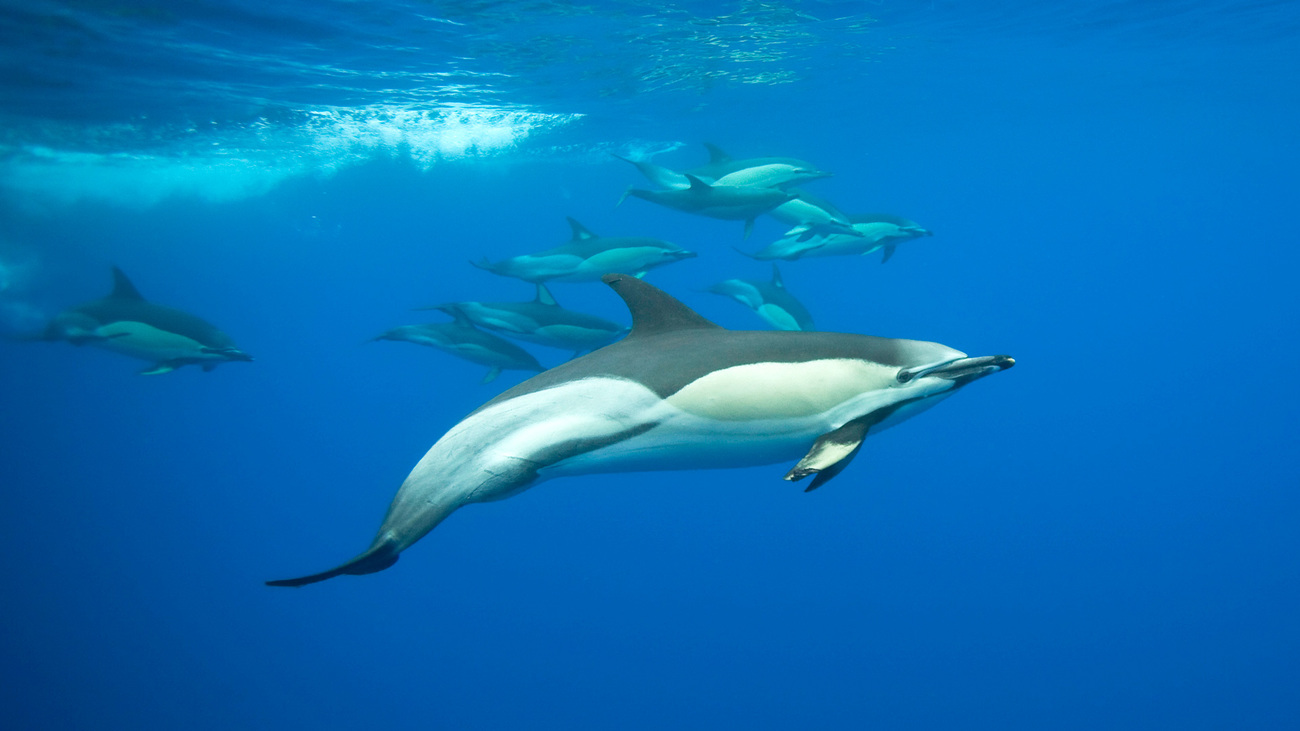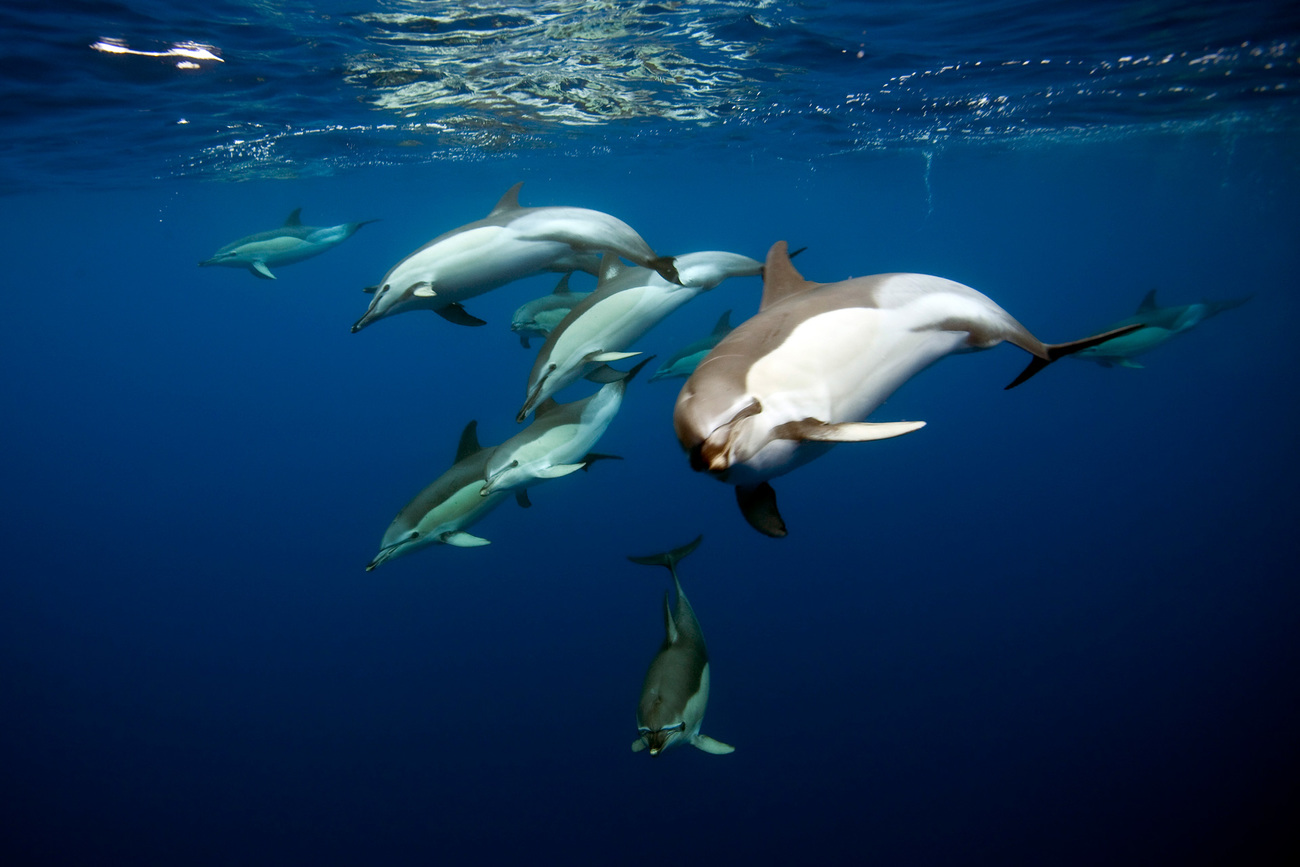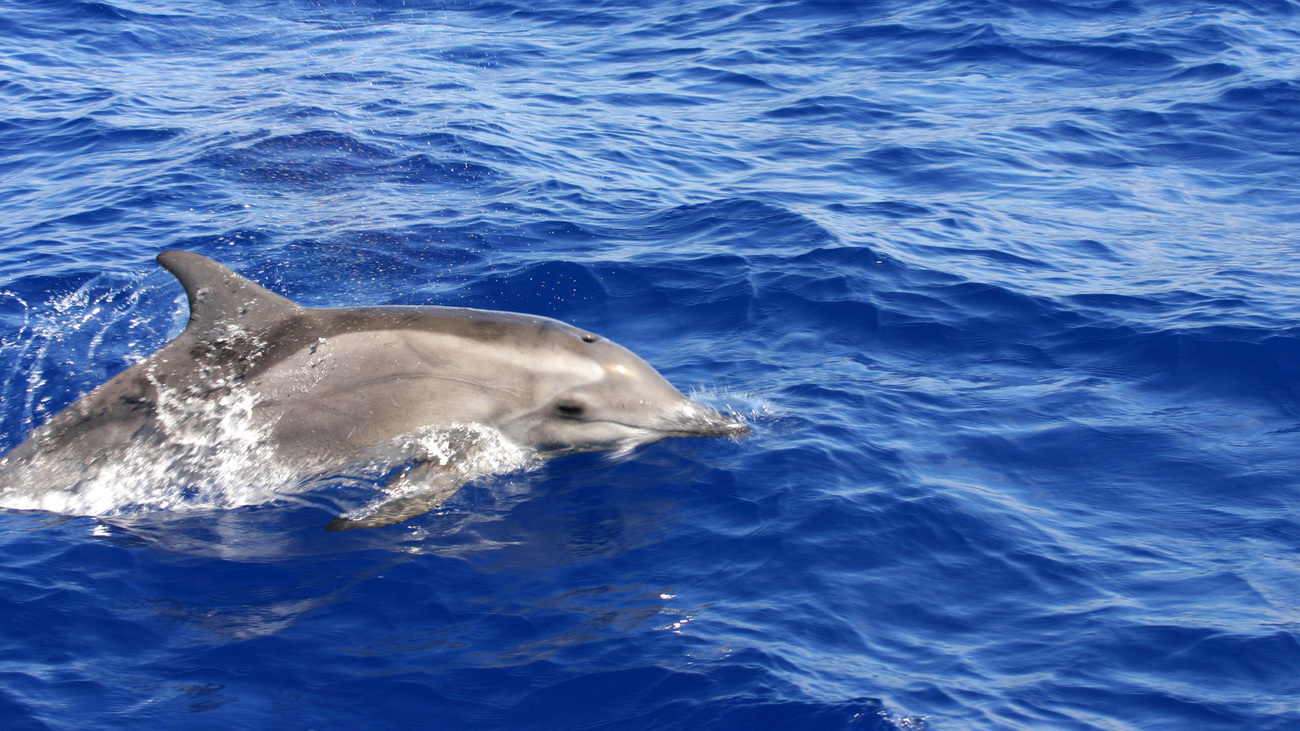Dolphins
What is a dolphin?
Dolphins are highly intelligent marine mammals that are seen as charismatic and beloved by humans. There are 40 dolphin species, grouped into six families. Six of these dolphin species are commonly—and mistakenly—referred to as whales, including the killer whale and the pilot whale.
Dolphins inhabit oceans and seas, as well as freshwater rivers and lakes worldwide. They are highly social animals, living in complex social groups known as pods. They engage in cooperative hunting, communicate through vocalisations and body language, and form strong social bonds within their pods.
As carnivorous apex predators, dolphins primarily feed on fish, squid, and occasionally crustaceans, using echolocation to locate and hunt their prey. These feeding habits help maintain ecological balance within the ocean’s ecosystem and regulate prey populations, preventing the overabundance of certain species.
Unfortunately, many dolphin species are endangered, with conservation organisations like IFAW working to protect these marine mammals and their habitats.
What is a dolphin’s scientific name?
Cetacea is the scientific name for dolphins, whales, and porpoises. The term ‘dolphin’ refers to any toothed whale belonging to the mammal family Delphinidae (oceanic dolphins), as well as river dolphins belonging to the Platanistidae and Iniidae families.
The scientific name for each dolphin varies depending on the species. Here are a few well-known dolphin species and their scientific names:
- Common bottlenose dolphins (Tursiops truncatus)
- Killer whales (Orcinus orca)
- Spinner dolphins (Stenella longirostris)
- Atlantic white-sided dolphins (Lagenorynchus acutus)
- Bottlenose dolphins (Tursiops truncatus)
Are dolphins endangered?
Depending on the species, dolphins’ conservation status ranges from least concern to critically endangered.
The Atlantic humpback dolphin is classed by the IUCN as critically endangered, with only an estimated 1,500 individuals left in the wild. Hector’s dolphin, which is endemic to New Zealand and the smallest marine dolphin in the world, is classed as endangered. The Irrawaddy dolphin, found in coastal Southeast Asia, and the freshwater Ganges river dolphin are also endangered, each with just a few thousand mature individuals left in the wild.
Where do dolphins live?
Dolphins live in a wide range of aquatic habitats, including both saltwater and freshwater environments. They’re highly adaptable animals, capable of living everywhere from tropical coral reefs to icy arctic waters, though the most recognisable species—the common and bottlenose dolphins—are found in warm, temperate waters.
While dolphins are well-adapted to life in the open ocean, they can thrive in coastal, shallow areas like bays and estuaries that are sheltered and have abundant food sources. Here, though, dolphins often come into contact with humans, which can threaten their survival. They can also become stranded if the water is too shallow.
While we tend to think of dolphins as sea animals, many coastal-dwelling dolphins spend a lot of time in freshwater and river dolphins live exclusively in freshwater, thousands of kilometres from the ocean. In rare cases, dolphins have been found in freshwater lakes, such as the Irrawaddy dolphin in certain areas of Southeast Asia.
Threats
Many species of dolphins face an array of threats—including habitat loss, pollution, and climate change—which have led them to be listed as endangered by the IUCN. Here are some of the biggest threats that conservationists are working to eradicate.

Entanglement in fishing gear
Like many marine species, dolphins are at risk of injury or death from commercial fishing practices. They can become entangled in various types of fishing gear, including gillnets, trawls, and longlines.
Once caught, dolphins may struggle to free themselves, leading to injuries, stress, or suffocation. Bycatch in fishing gear remains a significant cause of mortality for dolphins worldwide, particularly in areas with intensive fishing activities. It’s estimated that 300,000 whales and dolphins are killed by industrial fishing each year.
Ocean pollution
The ocean is full of pollution, which threatens the survival of everything from microscopic plankton to giant blue whales. Dolphins specifically face threats from pollution in the form of plastic debris, chemical pollutants, and oil spills.
Ingesting plastic debris can lead to internal injuries, blockages, and malnutrition, while chemical contaminants such as heavy metals and pesticides can accumulate in dolphins’ tissues, affecting their health and reproductive success.
Ocean noise
Dolphins rely heavily on echolocation and vocalisations for communication, navigation, and hunting. However, increasing levels of non-natural noises in the ocean, like those coming from ship traffic, commercial fishing, and sonar operations, can interfere with their sonar and echolocation, disrupting their behaviour.
Prolonged exposure to loud underwater noise may lead to stress, hearing damage, and displacement or fragmentation of dolphin populations.
Habitat loss
As we explored in the previous section, dolphins inhabit a variety of habitats, including coastal areas, estuaries, rivers, lakes, and open ocean environments. Sadly, all of these ecosystems are threatened by human activities.
Actions such as coastal development and dredging can degrade dolphin habitats, leading them to lose the places they’ve called home for millennia. Freshwater dolphins face the additional threat of dam construction, which leads to fragmentation and degradation of their habitats.
Climate change
The impacts of climate change pose significant challenges to all marine animals—including dolphin populations—by altering ocean temperatures, currents, and the presence of dolphins’ prey.
Rising sea temperatures can lead to changes in dolphin distribution and behaviour, with warm water affecting dolphins’ ability to properly reproduce.
Additionally, changes in sea level and storm patterns may exacerbate coastal erosion and habitat loss, further threatening dolphin populations. Large tidal fluctuations can also disorient dolphins when they’re swimming close to shore, leading to an increase in strandings.
FAQs
Are dolphins mammals?
Yes, dolphins are mammals. Just like other mammals, dolphins:
- are warm-blooded and regulate their body temperature internally
- give birth to live young
- nurse their offspring with milk produced by mammary glands
- breathe air, through a blowhole on the top of their heads
- are vertebrates with a spinal column
- exhibit complex social behaviours and provide parental care to their offspring
Are orcas dolphins?
Though orcas are known colloquially as killer whales, they are, scientifically speaking, dolphins.
Orcas are the largest members of the dolphin family.
What do dolphins eat?
All dolphins are carnivores, equipped with sharp teeth to help them eat their prey.
Various species of fish make up a significant portion of a dolphin’s diet, though they also consume squid, jellyfish, crustaceans, and octopuses.

How do dolphins sleep?
Dolphins have a unique way of sleeping that allows them to rest while still maintaining some level of awareness for their safety. As dolphins must actively surface to breathe air, they cannot fall into a deep, unconscious sleep like humans and other mammals do.
Instead, they engage in what is known as unihemispheric slow-wave sleep. One half of the brain can go to sleep, getting the rest it needs for survival, while the other half—and their other eye—stays alert and scans for threats.
Dolphins alternate between hemispheres periodically, allowing both sides of the brain to rest while still maintaining essential functions like breathing and awareness of their surroundings. It’s an adaptation that allows them to maintain their vital functions and remain safe in their marine habitat.
They typically sleep near the surface of the water or while swimming slowly, often in groups or with one or more dolphins keeping watch over the others.
How long can dolphins hold their breath?
This depends on the species, but on average, the maximum amount of time a dolphin can stay submerged is around 10 minutes. However, they usually dive for shorter durations as they swim, play, and hunt.
The record is held by a bottlenose that lasted 14 minutes underwater.
What is a group of dolphins called?
The collective noun for a group of dolphins is a pod.

Do dolphins have hair?
Although dolphins lack visible hair on their bodies, they are born with a few hairs around their mouths, which they lose shortly after birth and don’t regrow. These hairs are considered by scientists as vestigial remnants of their mammalian ancestry.
Are dolphins smarter than humans?
Dolphins are highly intelligent animals, but it’s not quite right to label them as ‘smarter’ than humans—it’s like apples and oranges.
Dolphins possess a remarkable cognitive capacity and exhibit behaviours that suggest high levels of intelligence, like problem-solving abilities, social complexity, communication skills, and self-awareness. They have large brains relative to their body size, with similar structures to humans in areas associated with memory, emotion, and sensory processing.
Meanwhile, human intelligence is characterised by unique features such as language, abstract reasoning, cultural complexity, and technological innovation—which we don’t see in dolphins.
How do dolphins mate?
Dolphin mating behaviour varies among different species, but there are some common patterns.
Once a male has successfully courted a female, a pair bond may form between them. This bond can be temporary or long-term, depending on the species. Dolphins engage in what looks like belly-to-belly copulation. It lasts anywhere from a few seconds to a couple of minutes.
Gestation periods vary by species but usually last around 12 months. When it’s time to give birth, female dolphins typically separate from their group to deliver their calf in a safe and secluded area.
Once born, the mother provides care and protection to her calf, nursing it with milk produced by her mammary glands and teaching it survival skills. The typical interval between calves from a single female varies from about three to five years.
How do dolphins communicate?
Dolphins produce a wide range of sounds, including clicks, whistles, chirps, and pulsed calls. These vocalisations serve as echolocation for navigation and hunting, as social communication between individuals, and for expressing emotions like excitement or distress.
The marine mammals also communicate through various body movements and postures, including swimming patterns, leaps, flips, and gestures such as tail slaps or head-butting. These behaviours convey information about their intentions, emotions, and social status within their group.
How fast can a dolphin swim?
Dolphins are sleek and speedy animals in the water. Though their cruising speed is 13 to 16 kilometres (8 to 10 miles) per hour, they can swim at speeds up to 40 kilometres (25 miles) per hour.
Our work
Dolphins face many threats due to human activity, but IFAW is working hard to help protect their populations.
In 2023, unusually low water levels and high temperatures in Lake Tefé, Brazil, caused mass casualties of endangered Amazon and Tucuxi river dolphins. IFAW experts were dispatched as part of an emergency team sent to respond to dolphins in distress and train locals on what to do if the situation happens again.
IFAW also helped establish the Dolphin Rescue Center on Cape Cod, an area where an increasing number of dolphins get stranded due to rapidly changing coastal tide conditions as a result of global warming. The first-of-its-kind centre rescues stranded dolphins, provides intensive care, and rehabilitates the mammals before releasing them back into the wild once they’re fully recovered.
Our stranding response program for dolphins and whales along Cape Cod is the most comprehensive cetacean rescue program in the world. Nearly 80% of stranded dolphins are released back into the wild.
In 2023, IFAW celebrated 25 years of marine mammal rescue. What started with a small team of passionate conservationists has grown into a 150-strong army of volunteers who have saved over 7,000 stranded whales and dolphins.
It’s no easy feat, either: last year a Risso’s dolphin that was stranded on the beach weighed an estimated 315 kilograms (715 pounds), and required 30 responders for it to be safely rescued. While this female was being rescued, another call came in about a stranded Risso’s dolphin calf a short way down the coast. Thankfully, with hard work from IFAW’s team and the Coast Guard, both dolphins were rescued and re-released.

How can you help?
The only way that IFAW can continue lifesaving work for endangered species like dolphins is through help from people like you.
